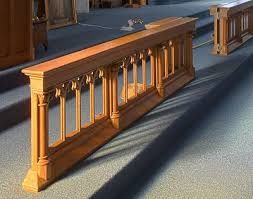

Q. 1. What is the purpose of the Communion rail?
A. 1. Prior to Vatican II, a Communion rail was mandatory in every Catholic Church. In those days, the communicant would kneel behind the Communion rail to receive Holy Communion on the tongue.
The Communion rail, also known as an "Altar rail" or "chancel rail", is a low barrier, sometimes ornate and usually made of stone, wood or metal in some combination, delimiting the Sanctuary and Altar in a Church, from other parts of the congregation. Often a gate, or just a gap, at the centre divided the line into two parts.
Newly constructed Catholic churches rarely have Communion rails, which were once general in parish churches, those of the late nineteenth century being particularly decorative. Communicants receiving the Eucharist knelt at the railings to be given Communion by a priest; today they typically stand. After the Second Vatican Council, many parishes removed their Altar rails, and an unfounded idea arose that the Council or the Holy See had ordered the change. Previously, only Altar servers were allowed to join the clergy within the Sanctuary during the celebration of the Holy Mass. Now, lay readers of Scripture and extraordinary ministers of Holy Communion enter the sanctuary during Mass.
Some Catholics and many architects and planners criticised some removals, often on liturgical, historical and ęsthetic grounds. While in some states, the Roman Catholic Church has adopted a minimalist approach towards the removal of Altar rails, in other countries, for example in Ireland, almost every re-ordering eliminated Altar rails. Many Catholics resisted the changes: some took legal action to try to prevent the removal of Altar rails and of other traditional features in pre-Vatican II Sanctuaries. Not all liberal Catholics supported the changes to Sanctuaries; some disputed the belief that the Altar rails were a barrier, claiming that many Churches were able to allow full participation by the laity in the revised Order of the Mass without removing Altar rails.
The General Instruction of the Roman Missal states explicitly that the sanctuary "should be appropriately marked off from the body of the Church either by its being somewhat elevated or by a particular structure and ornamentation".
While a Diocesan Bishop is competent to decide on concrete questions concerning the setting up or removal of Altar rails in a church in the diocese committed to his pastoral care, he is required prudently to make that decision in accordance with the norms of law, taking into account the wishes of the faithful. Any decision taken by the Bishop, however, may be appealed by hierarchical recourse to the competent instance of the Holy See which, in this case, is the Congregation for Divine Worship and the Discipline of the Sacraments.
[Source: https://en.wikipedia.org/wiki/Altar_rail]
At present, in 2018, there is a movement by many, especially those promoting the Traditional Tridentine Latin Mass, to have Communion rail reinstalled in their Churches. There appears to be little, if any, resistance to this return to the past. Many sees this as a necessity to bring back reverence in the Churches and its Liturgy.